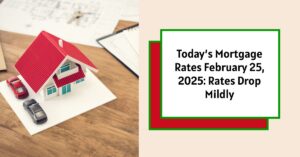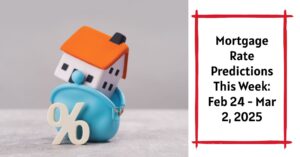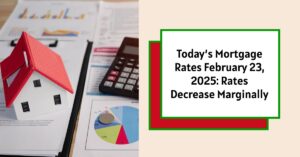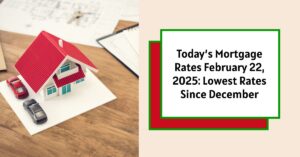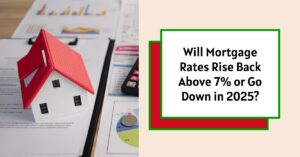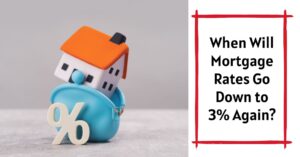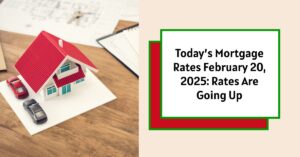Thinking about buying a house or refinancing your current mortgage? Well, you're definitely not alone! One of the first things anyone looking at the housing market wants to know is: what are mortgage rates doing today? So, let's cut right to the chase. As of today, February 25, 2025, the average interest rate for a 30-year fixed mortgage sits at 6.93%.
That's a tiny dip of 0.03% compared to last week. Rates are still pretty much holding steady, which means understanding where things are at right now is super important whether you’re buying your first home or just keeping an eye on your options. Let's dive into what these rates mean for you and what's happening in the mortgage world today.
Today’s Mortgage Rates February 25, 2025: Rates Drop Mildly
Breaking Down Today's Mortgage Rate Snapshot
Let's be real, numbers can be confusing, especially when you're talking about big things like home loans. But it's really about understanding the basics. Think of mortgage rates as the price you pay to borrow money to buy a house. Just like prices for groceries or gas, these rates can change. To help make sense of it all, here’s a quick look at the average mortgage rates you'll see today for different types of loans by Bankrate:
| Type of Mortgage | Current Rate (%) | Change from Last Week |
|---|---|---|
| 30-Year Fixed Mortgage | 6.93% | -0.03% |
| 15-Year Fixed Mortgage | 6.27% | 0.00% |
| 30-Year Fixed Jumbo | 7.06% | +0.01% |
| 5/1 Adjustable Rate Mortgage (ARM) | 6.23% | -0.03% |
| 10-Year Fixed Rate | 6.27% | +0.16% |
Okay, so what does this table really tell us? The 30-year fixed mortgage is the most popular choice for a reason. It gives you a steady interest rate for 30 years, which makes your monthly payments predictable. At 6.93%, it's still on the higher side compared to a few years ago, but it has eased off a little bit. The 15-year fixed mortgage has a lower rate at 6.27%, which means you'll pay less interest overall. The catch? Your monthly payments will be higher because you're paying off the loan in half the time.
Now, let's talk about jumbo loans. These are for bigger mortgages, usually when you're buying a more expensive home. The 30-year fixed jumbo rate is a bit higher at 7.06%. Then there are Adjustable Rate Mortgages (ARMs), like the 5/1 ARM. The rate starts lower (6.23% for a 5/1 ARM today), but after a set period (in this case, 5 years), the rate can change based on market conditions. Finally, the 10-year fixed rate is at 6.27%, offering a quicker payoff than a 15 or 30-year loan, but again, with higher monthly payments.
For those thinking about refinancing, meaning replacing your current mortgage with a new one, here’s how refinance rates are looking today:
| Type of Refinance | Current Rate (%) | Change from Last Week |
|---|---|---|
| 30-Year Fixed Refinance | 6.94% | +0.01% |
| 15-Year Fixed Refinance | 6.32% | +0.06% |
| 10-Year Fixed Refinance | 6.30% | +0.16% |
You can see refinance rates are pretty close to purchase rates, with the 30-year fixed refinance at 6.94%. If you're considering refinancing, you'd want to check if the new rate and terms make sense for your financial situation, considering things like closing costs and how long you plan to stay in your home.
What's Behind These Mortgage Rate Numbers?
Mortgage rates don't just pop out of thin air. They are heavily influenced by what's happening in the wider economy, especially by the Federal Reserve (often just called “the Fed”). Think of the Fed as the central bank of the United States. One of their main jobs is to keep inflation under control. Inflation is when prices for things like groceries and gas go up over time. To manage inflation, the Fed can adjust interest rates.
Last year, to combat high inflation, the Fed raised interest rates quite a bit. This had a direct impact on mortgage rates, pushing them up. More recently, the Fed has paused on raising rates and there was even talk of cutting rates, which would usually lead to lower mortgage rates. However, as we see from today’s numbers, mortgage rates haven’t dropped dramatically yet.
Why is that? Well, it's a bit like pushing a big ship – it takes time and continued effort to change its direction. Even though the Fed might be signaling a shift towards lower rates in the future, the effects aren't immediate. Plus, there are other economic factors at play, like ongoing concerns about inflation not coming down as quickly as hoped. If inflation stays stubbornly high, it could prevent mortgage rates from falling significantly.
Recommended Read:
Mortgage Rates Trends as of February 24, 2025
Mortgage Rates Drop to 2-Month Low Boosting Housing Affordability
Mortgage Rates Forecast March 2025: Will Rates Finally Drop?
Expect High Mortgage Rates Until 2026: Fannie Mae's 2-Year Forecast
Will Mortgage Rates Go Up as Inflation Surges Back Up to 3%
Figuring Out Your Monthly Mortgage Payment
Okay, interest rates are one thing, but what most of us really want to know is: what will my monthly payment be? That's where these percentages turn into real dollars and cents. Let's break down what you can expect to pay each month based on today's average 30-year fixed mortgage rate of 6.93%, for different loan amounts.
Think about it this way – your monthly mortgage payment is basically made up of principal (the amount you borrowed) and interest (the cost of borrowing). Over time, you gradually pay off the principal, and the interest rate determines how much extra you pay for the privilege of borrowing the money.
Let's look at some common mortgage amounts and their estimated monthly payments at 6.93%:
For a $150,000 Mortgage
If you're borrowing $150,000, your estimated monthly payment would be around $990.16. For many first-time homebuyers or those in areas with lower home prices, a $150,000 mortgage might be in the ballpark. That monthly payment gives you a solid idea of what to budget for housing each month.
For a $200,000 Mortgage
Stepping up to a $200,000 mortgage, your monthly payment would be approximately $1,320.22. This is a common loan amount in many parts of the country. It's important to remember that this is just the mortgage payment itself. You'll also have to factor in property taxes, homeowner's insurance, and potentially private mortgage insurance (PMI) if you put less than 20% down.
For a $300,000 Mortgage
If you're aiming for a $300,000 mortgage, expect a monthly payment of about $1,980.32. As you can see, as the loan amount increases, so does the monthly payment, and it starts to become a more significant portion of your monthly expenses.
For a $400,000 Mortgage
A $400,000 mortgage would result in a monthly payment of roughly $2,640.43. This kind of payment really highlights the importance of being financially prepared before you buy a home. It's not just about qualifying for the loan; it's about comfortably managing that payment every month for potentially decades.
For a $500,000 Mortgage
Finally, for a $500,000 mortgage, the estimated monthly payment jumps to around $3,300.54. For larger loans like this, careful budgeting and financial planning are crucial. Homeownership is a big commitment, and understanding these numbers is a key part of making smart decisions.
Here’s a handy table summarizing these monthly payment estimates:
| Mortgage Amount | Estimated Monthly Payment at 6.93% |
|---|---|
| $150,000 | $990.16 |
| $200,000 | $1,320.22 |
| $300,000 | $1,980.32 |
| $400,000 | $2,640.43 |
| $500,000 | $3,300.54 |
Keep in mind, these are just estimates and your actual payment could vary slightly depending on your specific loan terms, lender fees, and other factors. It’s always best to get personalized quotes from lenders based on your own situation.
What's the Outlook for Mortgage Rates Going Forward?
So, what can we expect in the future when it comes to mortgage rates? Honestly, predicting the future is never easy, especially in the world of economics. However, experts who watch the mortgage market closely are generally expecting rates to stay in a similar range for a while. Many predictions suggest that mortgage rates will likely hover between 6% and 7% for the rest of this year.
Unless there are major surprises in the economy – like a sudden spike in inflation or a big shift in the Fed's policies – it's unlikely we'll see drastic drops in rates anytime soon. This means that if you're planning to buy a home, it's probably wise to prepare for rates to remain in this range for the foreseeable future.
It's also important to remember that mortgage rates aren’t the only factor affecting home affordability. Things like stagnant wage growth (meaning our paychecks aren't increasing as fast as the cost of living) and the ongoing shortage of homes for sale also play a big role. Even if mortgage rates were to come down a bit, these other challenges could still make homeownership feel out of reach for many people.
My Take?
The current mortgage rate environment is a bit of a mixed bag. Rates are still elevated compared to the rock-bottom levels we saw a few years ago, but they've also stabilized somewhat recently. For potential homebuyers, it means you need to be realistic about your budget, shop around for the best rates and terms, and be prepared for the long-term financial commitment of homeownership.
It's definitely a market that requires careful planning and a clear understanding of the numbers. Don't be afraid to ask questions and get help from experienced professionals – like mortgage lenders and real estate agents – to navigate this process. Buying a home is a big decision, and having good information is your best tool.
Work with Norada in 2025, Your Trusted Source for
Real Estate Investing
With mortgage rates fluctuating, investing in turnkey real estate
can help you secure consistent returns.
Expand your portfolio confidently, even in a shifting interest rate environment.
Speak with our expert investment counselors (No Obligation):
(800) 611-3060
Recommended Read:
- Mortgage Rates Forecast for the Next 3 Years: 2025 to 2027
- 30-Year Mortgage Rate Forecast for the Next 5 Years
- 15-Year Mortgage Rate Forecast for the Next 5 Years
- Why Are Mortgage Rates Going Up in 2025: Will Rates Drop?
- Why Are Mortgage Rates So High and Predictions for 2025
- Will Mortgage Rates Ever Be 3% Again in the Future?
- Mortgage Rates Predictions for Next 2 Years
- Mortgage Rate Predictions for Next 5 Years
- Mortgage Rate Predictions: Why 2% and 3% Rates are Out of Reach
- How Lower Mortgage Rates Can Save You Thousands?
- How to Get a Low Mortgage Interest Rate?
- Will Mortgage Rates Ever Be 4% Again?
